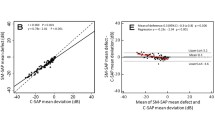Abstract
Spatial resolution perimetry and conventional perimetry measure different qualities of the functional performance of the eye. Theoretically, spatial resolution is directly related to the density of intact sensory units, but the relation of intensity to the density of intact sensory units is unknown. Previous studies indicated an almost linear relationship of global indices of spatial thresholds and intensity thresholds. The purpose of our study is to look at any difference in the behaviour of local threshold values and their precise relation. We examined 41 eyes of 23 patients with open angle glaucoma. Perimetry was carried out using the Humphrey Field Analyzer, and program 30-S or program 30-2 and the ring perimeter and standard program. Because test point patterns of the two examinations were different, the best matching points were calculated. If the distance between next points in both examinations was more than 5 degrees, the location was excluded. The Humphrey program 30-2 provided 47 matching points, the Humphrey program 30-S furnished 49 matching points for 50 locations. For the range of 20.36 dB in conventional perimetry, linearity could be verified in relation to the local thresholds in ring perimetry. The spatial threshold units used in the ring perimeter are the logarithm of spatial extend. Vice versa, spatial resolution is a power function of spatial thresholds. Based on the linear relationship of both thresholds, spatial resolution is a power function of intensity thresholds. In other words, if the intensity threshold is reduced from 36 to 30 dB, the spatial resolution is nearly half. If intensity threshold is reduced by a further 6 dB, spatial resolution is diminished to one quarter, and so on. If we accept that two-dimensional spatial resolution is directly related to the density of functional units, most of these units are lost when only small changes in dB values of conventional perimetry occur. For revaluation of visual fields in early glaucoma, our results are important for the otherwise rather meaningless decibel numbers.
Similar content being viewed by others
References
Bynke H. Evaluation of high-pass resolution perimetry in neuro-ophthalmology. In: Heijl A (ed) ‘Perimetry update 1988–89: Proceedings of the VIIIth International perimetric society meeting, Vancouver, May 1988’. Kugler & Ghedini, Amsterdam, pp 143–149, 1989.
Chauhan BC, House P. Intratest variability in conventional and high-pass resolution perimetry. Ophthalmol 1991; 98: 79–83.
Dannheim F, Abramo F, Verlohr D. Comparison of automated conventional and spatial resolution perimetry in glaucoma. In: Heijl A (ed) ‘Perimetry update 1988–89: Proceedings of the VIIIth International perimetric society meeting, Vancouver, May 1988’. Kugler & Ghedini, Amsterdam, pp 383–392, 1989.
Drum B, Severns M, O'Leary D, Massof R, Quigly H, Breton M, Krupin F. Pattern discrimination and light detection test different types of glaucoma damage. In: Heijl A (ed) ‘Perimetry update 1988–89: Proceedings of the VIIIth International perimetric society meeting, Vancouver, May 1988’. Kugler & Ghedini, Amsterdam, pp 341–347, 1989.
Drum B, Breton M, Massof R, Quigley H, Krupin T, Leight J, Mangat-Rai I, O'Leary D. Pattern discrimination perimetry: a new concept in visual field testing. Doc Ophthalmol Proc Ser 1987; 49: 433–40.
Fitzke FW, Poinoosawmy D, Ernst W, Hitchings RA. Peripheral displacement thresholds in normal, ocular hypertensives and glaucoma. Doc Ophthalmol Proc Ser 1987; 49: 447–452.
Frisén L. Acuity perimetry: estimation of neural channels. Intern Ophthalmol 1988; 12:169–74.
Frisén L. Vanishing optotypes. A new type of acuity test letters. Arch Ophthalmol 1986; 104:1194–8.
Johnson CA, Scobey RP. Foveal and peripheral displacement thresholds as a function of stimulus luminance, line length and duration of movement. Vision-Res 1980; 20(8): 709–15.
Lachenmayr B, Rothbächer H, Gleissner M. Automated flicker perimetry versus quantitative static perimetry in early glaucoma. In: ‘Perimetry update 1988–89: Proceedings of the VIIIth perimetric society meeting, Vancouver, May 1988’. Kugler & Ghedini, Amsterdam, pp 359–368, 1989.
Lachenmayr B. Die zeitlichen Übertragungeigenschaften des visuellen Systems. Fortschr Ophthalmol 1988; 81:170–4.
Quigley HA, Dunkelberger GR, Green WR. Retinal ganglion cell atrophy with automated perimetry in human eyes with glaucoma. Am J Ophthalmol 1989; 107: 453–64.
Weber J, Kosel J. Glaukomperimetrie — Die Optimierung von Prüfpunktrastern mit einem Informationsindex. Klin Monatsbl Augenheilkd 1986; 189:110–7.
Author information
Authors and Affiliations
Rights and permissions
About this article
Cite this article
Bartz-Schmidt, K.U., Weber, J. Comparison of spatial thresholds and intensity thresholds in glaucoma. Int Ophthalmol 17, 171–178 (1993). https://doi.org/10.1007/BF01007736
Received:
Accepted:
Issue Date:
DOI: https://doi.org/10.1007/BF01007736




